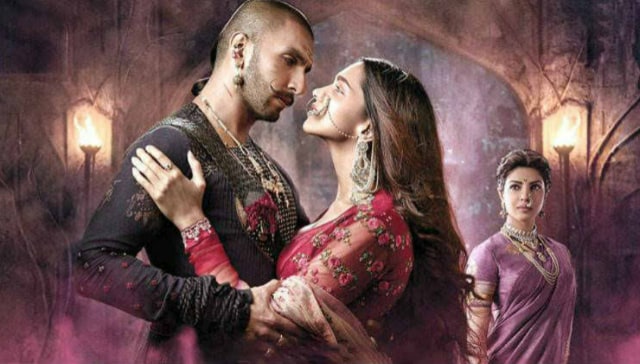If K. Asif were alive he would smile at what Sanjay Leela Bhansali has achieved in Bajirao Mastani. You sense you are in the presence of something extraordinarily creative the minute you step into the world of Bajirao Mastani, a costume drama clothed in conceit. The magician, who uses colours to convey emotions, Bhansali conceives the Bajirao-Mastani liaison as a striking fusion of saffron and green colours. The two colours dominate Bhansali’s palate, spilling over in streams of sublimated drama. The spoken words are at once colloquial and royal so that we the audience don’t get isolated from the cascade of rhetorics. Indeed Prakash Kapadia Dialogues are, in many vital ways, the plot’s backbones. The characters exhale a verbal vitality that never slips into verbosity. We can’t imagine them speaking in any other way.
I especially liked a sequence where Deepika‘s Mastani, armed with the confidence of a woman consumed by love no matter how forbidden, barges into the christening ceremony of her lover’s legitimate baby boy. When taunted for tainting the occasion with green, Mastani gently reminds the congregation that saffron and green, are at the end of the day, blood brothers used in Hindu and Muslim religious events.
This is a film to view many times, once just for the way colours are used to convey emotions. When Bajirao heads home after a war victory his buoyant wife dances with a gigantic saffron flag unfurling in tandem with her joyous heart. The visual and emotional impact of the moment is so exhilarating that you want to clutch Kashibai’s ecstasy close to your heart.
In another moment when colours talk, we have Bajirao’s wife and mother sharing a bonding based on mutual grief sewing saffron flags, the mother (Tanvi Azmi, brilliant) wryly laughing about Bajirao’s sudden eruption of passion for Mastani and saying, “We might as well be sewing green flags from now on.”
Looking back on the experience SLB says, “We knew some kind of magic was happening. As the shooting progressed I realized we were doing something that had the blessings of great filmmakers. So yes, we did know we were blessed.”
The era of the plot, tone of the storytelling, texture of music were all alien to today’s audiences. But Bhansali was never fearful of losing the audience. “I lived with the script for twelve long years. Over the years I read it over and over again and continued to be thrilled by it. Every time I read it I realized Bajirao Mastani must be made. It was so powerful a screenplay. I never considered what the budget would be, or that audiences may not connect with the classical flavour. There was no fear of failure when I made Bajirao Mastani. I am a fearless filmmaker.”
Bhansali had no trepidation about the rejection by the audience of a costume drama. “Audiences want to see something interesting. It doesn’t matter which genre or period it belongs to. It is the conviction with which a filmmaker puts across his vision which works. But yes, I did make Bajirao Mastani keeping today’s audiences in mind. The structuring the lighting…were all done for a contemporary audience. I was throughout sure of what I was doing. But yes, there was always a nervousness around me, people asking if today’s audience thinks this way.
Bhansali feels a good love story can never fail. “ Love is universal and we must love the one that we love without barriers of religion. Bajirao was a fierce warrior and he defended his land and people with single-minded devotion. But when it came to loving Mastani he was supremely secular. Somewhere in my mind the colours saffron and green emerged from my plot and merged in my mind.”
Bhansali admits Bajirao is the most powerful and magnetic hero he has ever filmed. “Bajirao was one of the most powerful statesmen of India. He believed in protecting and fighting for his land. He won 40 wars. But he lost in love. 350 years down the line I’ve paid a tribute to his love story.”
The epic filmmaker acknowledges the influence of K Asif’s Mughal-e-Azam is very strong on the film. “My film is a tribute to Mughal-e-Azam. The kind of work Asif Saab did, his imagery and visuals, were very inspiring for me. I am deeply impressed by the works of Mehboob Khan, Raj Kapoor and V Shantaram. I’ve learnt filmmaking by watching these masters. Deepika dancing to Mohe rang do lal is directly inspired by Madhubala’s Mohe panghat pe nandlal ched gayo re in Mughal-e-Azam. Deep inside me, there was the fear …what if people compare me poorly? Luckily for me, no one has said I’ve made a fool of myself. The story, music, visuals and scenes are all part of the Indian sensibility. Singing dancing celebrating …these are all part of our culture. They’ll never die from our cinema.”
Bhansali tries to follow the epic masters of Hindi cinema. “I’ve tried, and I think I’ve succeeded to some extent in Bajirao Mastani. There is still so much to be learnt absorbed and reinvented. The past is very important to my cinema. History is not only important to a nation. It’s also important to cinema. If we don’t acknowledge the cinematic greats in our film we’re guilty of ignoring history.”
Subhash K Jha is a Patna-based journalist. He has been writing about Bollywood for long enough to know the industry inside out.
Read all the Latest News, Trending News and Entertainment News here. Follow us on Facebook, Twitter and Insta

